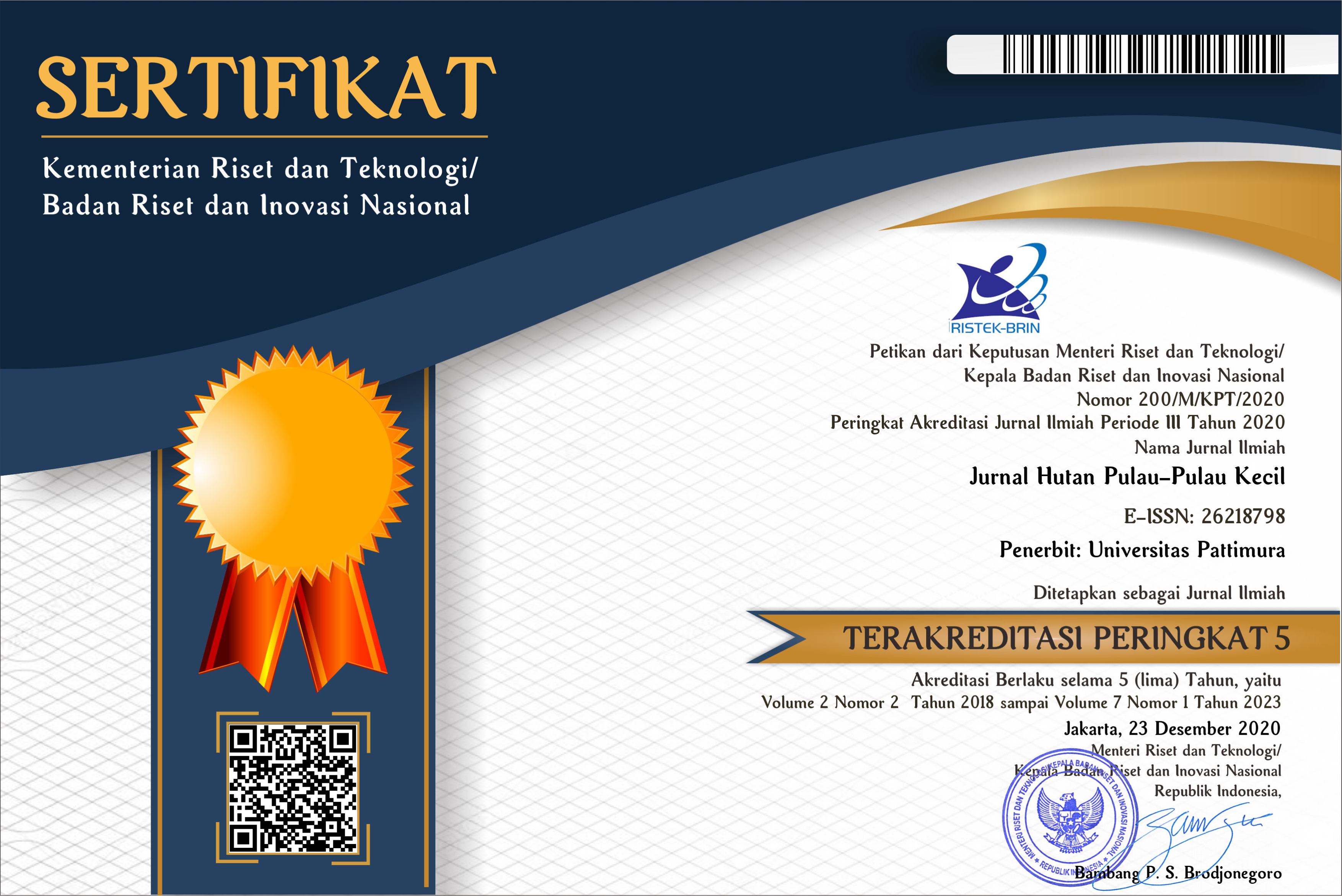PERTUMBUHAN SAGU (Metroxylon sp) DI HUTAN ALAM PAPUA
Abstract
Sago plants (Metroxylon sp) is a type of palm tree that grows around swamps and waterlogged land in the tropics. Sago palms grow on muddy land, with the quantity of water varies greatly, ranging from dry land to land remained logged. The longer the land flooded, the growth of young plants (shoots / seedling) very rapidly, but the growth of the trees are very slow. This study aims to determine the relationship of the growth of sago (Metroxylon sp) with climatic factors (humidity, temperature, light) and biotic (plants or other vegetation). The results showed that the relationship of growth of sago with environmental factors, edaphic (water), climatic (humidity, light) and biotic factors (vegetation) are generally water has an influence on the growth of sago while the humidity factor for all types of places to grow, that is, the area stagnant water, temporary areas and dry areas do not affect the growth of sago.
Downloads
References
Adisewejo. R.S. 1991. Bercocok Tanam Tebu (Sacharum officinum). Bale Bandung, Bandung.
Auri, J. P. 1991. Keadaan Hutan Sagu Di Irian Jaya. Makalah Seminar Pengembangan Sumberdaya Sagu Di Irian Jaya, Manokwari 10 -11 Desember.
Barahima. 2006. Keragaman Genetik Sagu di Indonesia berdasarkan Penanda Molekuler Genom Kloroplas dan Genom Inti (disertasi). Bogor. Sekolah Pascasarjana, Institut Pertanian Bogor.
Fitter. A. H dan R. K. M. Hay 1992. Fisiologi Lingkungan Tanaman. Gadjah Mada University Press. Yogyakarta.
Flach, M. 1983. The Sago Palm : Domestication, Exploitation and Product. Preprint. FAO Plant Production and Protection. Rome. 85p.
Flach, M. 1977. The Sago Palm and its Yield Potential. First Internaasional Sago Symposium in Serawak. Univ. of Malaya Press
- Kuala Lumpur.
Hardjowigeno, S. 1987. Ilmu Tanah Meltron Putra.Jakarta
Harsanto, P. B. 1986. Budidaya Dan Pengolahan Sagu. Penerbit Kanisius, Yogyakarta.
Haryanto dan Pangloli. 1992. Potensi dan Pemanfaatan Sagu. Penerbit Kanisius, Yogyakarta,140p.
Kartasapoetra. G., A. G. Kartasapoetra dan M. M. Sutedjo 1987. Teknologi Konservasi Tanah dan Air. Meltron Putra, Jakarta.
Krivan V and Sirot E. 2002. Habitat Selection by to Competing Species in a Two Habitat Environment. J The American Naturalist 160 (2) : 214 -234
Kurniawan A, Undaharta Ni KE, Pendit I Made R. 2008. Asosiasi Jenis-Jenis Pohon Dominan di Hutan Dataran Rendah Cagar Alam Tangkoko, Bitung, Sulawesi Utara. J Biodiversitas 8 (3) : 199-203.
Manan, S., S. Soepangkat, Y. Abas, dan S. Sukandar. 1984. Conservation Program on Sago Palm in Indonesia. Paper Presented at The Expert Consultation in the Development of the Sago Palm and Palm Products, Jakarta , Januari 16
– 21, 1984.
Matanubun H et al. 2005. Feasibility study of the natural sago forest for the establishment of the commercial sago palm plantation at Kaureh District, Jayapura, Papua Province Indonesia. (Edt. Yan P. Karafir, Foh. S. Jong, and Cictor E. Fere). Proceeding of the eighth International sago symposium, Jayapura, August 4-6, 2005.
Prihastanti, E. 2010 .Perkecambahan Biji dan Pertumbuhan Semai Tanaman Jarak Pagar. Anatomi dan Fisiologi, 8(1) : 49-56.
Samin Botanri, Dede Setiadi, Edi Guhardja, Ibnul Qayim,dan Lilik B. Prasetyo. 2011. KarakteristikHabitat Tumbuhan Sagu (Metroxylon spp.) Di Pulau Seram, Maluku.
Suryani, C. L. dan Haryadi. 1998. Pemutihan dan Pengikatan Silang Pati Sagu dan Penggunaannya untuk Bahan Substitusi pada Pembuatan Bihun. Agritech 18: 20–23.
Sanchez, P. A. 1993. Sifat-Sifat dan Pengelolaan Tanah Tropika. ITB Bandung. Bandung.
Theodore. W. D, J. A. Helms dan F. S. Baker. 1987. Prinsip-prinsip Silvikultur. Gadjah Mada University Press. Yogyakarta




